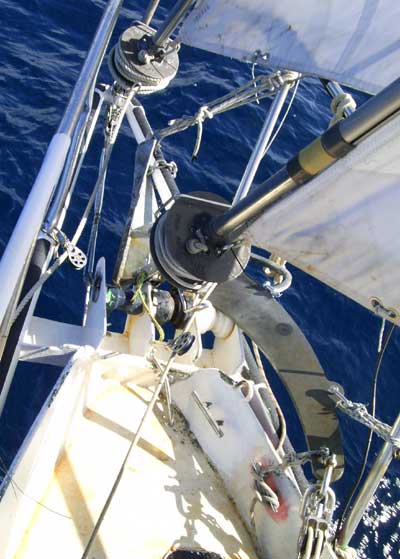 The anchor being lashed on by ropes and, later, chain to avoid the ropes being cut by the sharp edges of the anchor, as below, was enough to get through the near gale. No weather more severe was in the forecast, but I always try to have a plan for what to do if the wind gets two Beaufort Forces higher than expected. My plan for the new anchor, if we got into a Force 9 (Severe Gale), was to disconnect it, unlash it and jettison it at sea. I really didn’t like this idea–of throwing away a new and expensive anchor–but considering the damage that a loose anchor could do to the boat (especially the roller furlers, which I would need working later to continue sailing), if we encountered a severe gale, jettisoning the new anchor could be the least bad option. As it was a light headwind day, the waves were quite small, and it was feasible to think about carefully moving the anchor and securing it better. I hove to and spent most of the day preparing and moving the anchor to the position in the above picture. I drilled a hole in the fluke and put a shackle in so I could tie a rope to the fluke and rotate the anchor up where it could be better secured. The sharp edges of the Raya’s shank were rapidly cutting into the plastic roller. By putting the anchor into a position where it only contacted steel, I hoped to avoid it cutting the plastic more (which would cause further movement as it cut away its support). So, after almost a days work (one needs to be very careful and ready to move quickly to work with an anchor on the bowsprit at sea as the boat is still going up and down in the waves), the anchor was well supported and secured with enough chains and ropes connected to shackles that I felt it was ready for a severe gale. A few days later, there was a severe gale (Force 9), and I was very happy to have better secured the anchor, as it did stay in place. More about that later.
The anchor being lashed on by ropes and, later, chain to avoid the ropes being cut by the sharp edges of the anchor, as below, was enough to get through the near gale. No weather more severe was in the forecast, but I always try to have a plan for what to do if the wind gets two Beaufort Forces higher than expected. My plan for the new anchor, if we got into a Force 9 (Severe Gale), was to disconnect it, unlash it and jettison it at sea. I really didn’t like this idea–of throwing away a new and expensive anchor–but considering the damage that a loose anchor could do to the boat (especially the roller furlers, which I would need working later to continue sailing), if we encountered a severe gale, jettisoning the new anchor could be the least bad option. As it was a light headwind day, the waves were quite small, and it was feasible to think about carefully moving the anchor and securing it better. I hove to and spent most of the day preparing and moving the anchor to the position in the above picture. I drilled a hole in the fluke and put a shackle in so I could tie a rope to the fluke and rotate the anchor up where it could be better secured. The sharp edges of the Raya’s shank were rapidly cutting into the plastic roller. By putting the anchor into a position where it only contacted steel, I hoped to avoid it cutting the plastic more (which would cause further movement as it cut away its support). So, after almost a days work (one needs to be very careful and ready to move quickly to work with an anchor on the bowsprit at sea as the boat is still going up and down in the waves), the anchor was well supported and secured with enough chains and ropes connected to shackles that I felt it was ready for a severe gale. A few days later, there was a severe gale (Force 9), and I was very happy to have better secured the anchor, as it did stay in place. More about that later.
